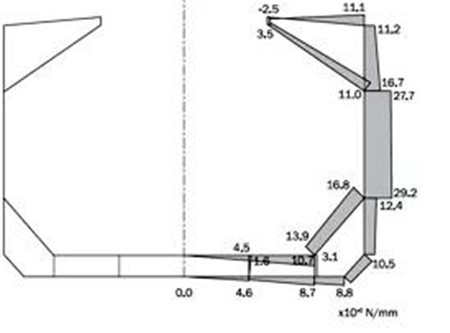Why do we need to revise the results of the shear force even the calculation process of the shear force of the hull beam seems impeccable as the calculation method of shear force correction for bulk carriers is clearly required in the CSR specification?
On hull beam, the shear force of the transverse section at the calculation of the hull is equal to the difference between the gravity and buoyancy of the ship on one side, and we can calculate the corresponding gravity and buoyancy accurately, so as to obtain the shear force received by the corresponding transverse section. This process is completely consistent with the theory of structural mechanics. According to the requirements of the specification , however, this result cannot be directly used for shear force verification. It should be corrected. Shear correction changes the shear distribution of the ship beam. So, how does the changes come, or how does it decrease?
When you calculate the shear force, the hull is regarded as a beam floating on the water surface, and the difference value between the weight distribution and the buoyancy distribution can form a curve. According to this curve, the shear force of the hull beam in a certain section can be obtained by integrating one side of this curve. The shear force is distributed in the cross section here in the form of shear flow. In the previous CSR standard, the shear flow distribution was calculated directly by the shear flow formula of the rectangular section beam, while the new version introduces the concepts of static shear and non-static shear, which can calculate results more reasonable. Although the methods in the two versions are different, the calculation thoughts are basically the same, both based on the beam system calculation method to obtain the shear force and base on the rectangular section beam shear flow method to calculate the shear flow of the cross section. The shear force of the structure near the neutral axis is larger and the further away the neutral axis is, the smaller the shear force is. The shear force is the least at the deck and bottom of the ship.

As shown in the above figure, we can see that the shear force on the bottom longitudinal is very small, which is inconsistent with the actual situation. Carefully analyse the load transfer in the hull structure, we can find that the vertical force on the hull is not fully transferred to the hull beam. The load on the bottom is the resultant force of internal cargo and external water pressure. The bottom load is transmitted to the longitudinal through the inner and outer plates, from the longitudinal to the strong, and then to the bottom longitudinal and the side plate. When the stiffness of the strong beam is enough, most of the load will be transferred to the side shell of the hull, and the shear flow distribution of the hull section will conform to the one of the hull structure calculated by the rectangular beam. In fact, however, the stiffness of the strong beam is mot enough. Some part of the load borne by the bottom is transferred to the side shell while some part of the load is directly borne bu the bottom stringers. Therefore, the distribution of the shear flow in the transverse section does not meet the general low of the rectangular section beam, and the shear glow on the bottom girder cannot be obtained by directly using the method of solving shear flow on the rectangular beam, and the results of shear flow on the side shell are nor accurate enough.
As we know, the shear flow of the transverse section is the integral of the shear flow along the vertical axis. Then, the shear force received by the bottom longitudinal girder can be removed from the one received by the hull cross-section, and the remaining shear force can be used as the one received by this cross-section and calculated according to the calculation method of rectangular beam shear flow, so as to obtain the shear flow of other members of the cross-section except the bottom longitudinal girder. This is the basic idea of shear force correction. Through the above analysis, it can be known that the shear force of the transverse section calculated according to the hull beam theory is the actual shear force of this section, and it does not be increased or decreased, which, however, cannot be used to calculate the shear flow of the corresponding cross section. The so-called shear correction is to correct the shear force of the bottom girder from the shear force of the transverse section, and then use the corrected shear force to calculate the shear flow of other hull members except the bottom girder according to the calculation method of the rectangular section beam. The shear force of the bottom girder should be calculated directly by the finite element method. In other words, the revised shear diagram does not represent the shear distribution of the entire hull beam, but the shear distribution of the hull structure except the bottom girder.

 CN
CN

![[list:title]](/static/upload/image/20240523/1716425568146093.jpg)
![[list:title]](/static/upload/image/20240523/1716425466730827.png)
![[list:title]](/static/upload/image/20240523/1716425496175720.png)
![[list:title]](/static/upload/image/20240523/1716425522476485.jpg)
![[list:title]](/static/upload/image/20240523/1716427565435344.jpg)
![[list:title]](/static/upload/image/20240306/1709710927521266.jpg)
![[list:title]](/static/upload/image/20240306/1709710907370023.jpg)
![[list:title]](/static/upload/image/20240306/1709710766128139.jpg)
![[list:title]](/static/upload/image/20240306/1709710749735821.jpg)
![[list:title]](/static/upload/image/20240306/1709710719323252.png)
